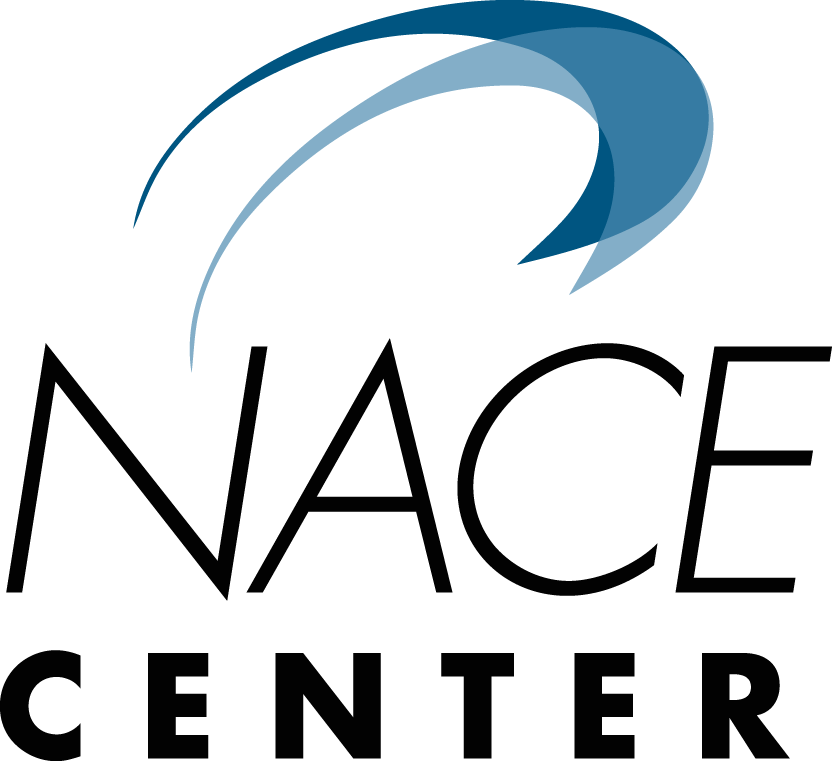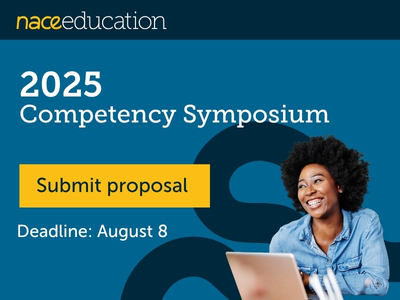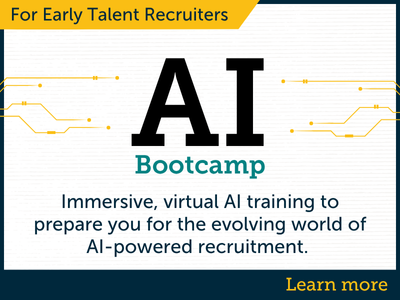NACE Journal / Spring 2025
Since early in the pandemic, I’ve been assessing and reporting on the current state of university recruiting—from the candidate’s perspective.
This article, the third in a series I’ve written for the NACE Journal, is the capstone that ties together the previous building blocks of authenticity and execution with the candidate experience and shows how these three elements shape an employer’s campus brand. (See Figure 1.) It tells the story, using unfiltered data culled from recent Scott Resource Group (SRG) student research, to provide clarity about what matters—and what doesn’t—as students consider employers and their opportunities during their candidate experience, as illustrated with this student’s comment:
“Authenticity was my deciding factor when recruiting for companies. I ended up choosing the company I signed with because they did not make me feel like a number, they made me feel like they wanted ME.”
We’ll start at the top of the pyramid in Figure 1 with execution, which comprises every touchpoint along the job-search continuum. Our focus will be two of today’s hot topics: 1) communication channel effectiveness and 2) the impact of what I’ve dubbed the “email tsunami” (and the related issue of the automated job recommendation mismatches).

Execution
Employers invest heavily—with budget outlays and staff resources—in attracting students to consider their opportunities. SRG has surveyed college students on an ongoing basis to assess the effectiveness of the wide range of outreach channels recruiters use, and “email sent directly from the employer’s domain” has remained top ranked over a significant time horizon. (See Figure 2.) What has also remained constant is students’ lack of valuing of both social media communication tools and third-party college portals.
Execution and Authenticity
More from Mary Scott:Execution Is the Secret Sauce That Drives Successful University Recruiting Results (Spring 2024 NACE Journal)
Why Authenticity Is Essential to an Impressive and Effective Candidate Experience (Spring 2023 NACE Journal)
While email sent directly from an employer’s domain remains the preferred candidate attraction communication channel, it is important to note that students do NOT expect individually crafted messaging at this stage. On the other hand, templated outreach campaigns, a widely used candidate communication channel, are rated and ranked among the least authentic sources of information because they appear to be spam—this is the students’ term—when not properly targeted and are clearly the same “insert name here” emails sent to countless classmates. (See Figure 5.)
Among the granular email-related shortfalls cited by participants of SRG’s fall 2024 research, these three surfaced:
- “The content of employers’ emails about their opportunities is of interest to me.” (6.48)
- “Emails I receive from employers are a good match with my interests.” (6.28)
- “Emails I received from employers about opportunities seem authentic.” (6.12)
(Note: These are based on a 10-point Likert scale, where 8.0+ indicated strongest agreement.)
Combine the less-than-enthusiastic endorsement level of these candidate experience ratings with what I have been referring to as the “email tsunami”
since first reporting the trend in early 2022, and we see increasing agreement—even during a challenging recruiting cycle—with the statement “I unsubscribed from or blocked some email messages I was receiving about job opportunities.”
(See Figure 3.)
It's not just the volume of email messaging that students consider a significant candidate experience dissatisfier, it’s the lack of congruence between the opportunities they are seeking and what lands in their inbox that is both annoying and signals a lack of authenticity rooted in what signals a palpable disinterest in them.
More than half of recent SRG survey participants agreed that “inaccurate job matches negatively impact my perceptions of an employer,” which has serious campus brand implications. (See Figure 4.) The takeaways—lack of authenticity and disinterest in their candidacy—are fully consistent in the unaided commentary that students provide in their text responses to the survey’s open-ended questions.
That lack of authenticity surfaced again when students assessed their trusted sources as they navigated their job search.



Authenticity
To that point, Figure 5 displays the truncated findings of a three-cycle year-over-year deep-dive I’ve conducted specific to “trusted sources of authentic information.” Each time we fielded the survey, students were presented with a roster of 35 recruiting strategies, tactics, and tools to assess relative to their authenticity.
The consistency in the resulting rankings is noteworthy: What students rate as their most trusted and least trusted sources has remained constant over time. The most significant takeaway, however, is this: What students continue to trust as authentic sources of information are all people-based; those in the bottom tier remain either technology-based and/or marketing sources.
A set of related findings appears as Figure 6. As reported in my previous NACE Journal articles, students overwhelmingly agree (at 92.5%) that “authenticity during the recruiting process is important to me.” As evidenced in the “trusted sources of authentic information” data presented in Figure 5, it follows that students are almost as likely to agree (at just over 90%) that “I value employer recommendations from people I know.” What does not comport with today’s conventional wisdom is the disagreement that “I value following social media influencers for job-search advice.” Fully 46% of SRG survey participants disagreed with the statement; only 26% agreed.
One of the popular narratives during COVID—and one that continues to have legs as a reason to offer virtual recruiting events—is that students prefer their convenience. Figure 7 provides comparative agreement ratings that not only push back against that ongoing talking point, but include strong evidence to support students’ preference for in-person engagement with employers. Additionally, more than 70% agree that they would prefer “to be interviewed on campus/in person for the initial screening round.”
What I find most interesting about the preference for on-campus/in-person initial round screening interviews is this: These students are not expressing a longing for how things used to be; they entered college after the pandemic put an end to the heyday of this previously commonplace practice.
So why do candidate experience preferences matter? Because students not only extrapolate from how they’re treated during the recruiting process to “what it’s like to work there” but as also illustrated in Figure 8, they are more likely to decline (or renege on) an offer if they don’t feel a genuine connection to the employer. That connection is the result of the employer developing an authentic relationship and delivering a consistent, professional, and respectful candidate experience from attraction through the offer process—which brings us to the current hot topic of employers using artificial intelligence to recruit students.




Artificial Intelligence Meets the Candidate Experience
As I write this article, there is an ongoing and consequential debate within the university recruiting community specific to the role of artificial intelligence (AI) going forward. There is considerable theorizing about how to best harness the promise of AI, with an eye toward reducing (at a minimum) “top of the funnel” human interaction to streamline recruiting processes and reduce cost.
The profession is awash in projections and pronouncements about how AI will transform university recruiting, with lots of prognosticating about what the “new playbook” will look like. The continuum ranges from a completely automated process to those who foresee a return to the pre-COVID execution model of “key schools” and campus recruiting teams. The latter maps to yet another current issue, somewhat related to the topic of this article, which is sorting through the challenge of fraudulent applicants and applications and the challenge for employers to gauge the authenticity of candidates. But that’s a discussion for another day.
I’ve been querying students since 2023 about their attitudes specific to employers’ use of AI to screen candidates, and their comparative agreement with the statement “I’m favorably impressed with employers’ use of artificial intelligence (AI) to screen candidates” shows an increasing level of disagreement. (See Figure 9.) Reasons for their lack of enthusiasm about AI as a screening tool is further illustrated in the response ratings displayed in Figure 10. Students disagree that they are “able to present their best, most authentic self” when AI tools are used and that “transitioning to AI ... will assure a more equitable outcome for applicants.” More than half of the survey participants agree, however, that “it’s fair we use tools like ChatGPT” to apply, if employers are using AI to screen candidates.
Lost in all the noise about artificial intelligence as a transformational advancement for the recruiting profession is the impact it is certain to have on the candidate experience—and ultimately on employers—the literal centerpiece of Figure 1 that displays university recruiting success differentiators.


Impact on Employment Brand
A recent LinkedIn post by a recruitment marketing manager stated that employer brand derives “from automated email campaigns and social posts and ‘day-in-the-life’ videos, each [a] touchpoint to ... highlight the culture, values, and what makes the organization unique.” As documented in this article, however, students use a different lens from experienced candidates—one that relies more on personal engagement—and that trend has surprisingly (to some) actually accelerated since COVID.
Hear More @ NACE25 in Philly
Mary Scott is presenting “Assessing the Impact of the Candidate Experience on Employer Brand” at NACE25 in Philadelphia.With apologies to Abraham Maslow, the Scott’s Hierarchy pyramid captures the essential elements of the UR candidate experience, as measured and valued by thousands of SRG survey participants since the pandemic. (See Figure 11.) It illustrates the foundational building blocks of execution, with the human differentiators of authenticity, specifically engagement and personalization.
Atop the pyramid sits an employer’s brand. It is quite simply the sum of the parts, as students assess the UR candidate experience. The quote alongside was a recent student contribution, but it reminded me of an earlier comment made by a focus group participant at Berkeley: “I tend to talk to my peers more and trust their opinions because to me, they aren’t obligated to tell you only good things and therefore would provide the most honest perspective.”
The significance of the quote is this: It dates to 2014. With as much as some of the tools used in recruiting have clearly changed—and will continue to do so—what matters to students (and why) remains constant. The pandemic and the emergence of AI have certainly added some conventional wisdom narratives to the discussion, but if we truly listen to students, university recruiting success drivers, differentiators, and employer brand remain deeply rooted in execution and authenticity—and in the candidate experience itself.







